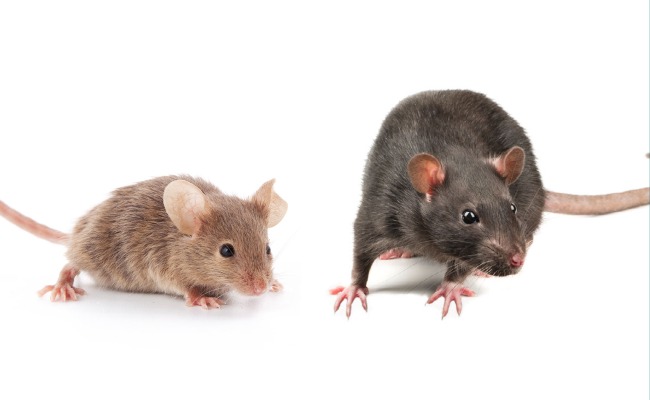When it comes to rodents, mice and rats are two of the most common pests homeowners have to deal with. While these two pests may look similar, there is a distinct difference between a mouse and a rat, like their appearance, behavior, and habits.
Understanding the differences between mice and rats can help you determine which pest you’re dealing with and how to eliminate them from your home effectively.
In this blog, we will dive into the key differences between mice and rats so you can get a better understanding of these common pests.
Mice and Rat Physical Differences
Norway rats, roof rats, and house mice are three common rodents found in homes, gardens, and agricultural areas.
As the largest of the three rodents, Norway rats, also known as brown rats, can grow as long as 18 inches with their tail included. Weighing in at 11-16 ounces, they have a heavy, stocky body and a blunt, scaly tail shorter than their body.
Roof or black rats are smaller than Norway rats with slender bodies. They are typically 12-14 inches long, with trails longer than their bodies. Roof rats are excellent climbers and are often found in attics, trees, and high places.
House mice are the smallest of the three, with an average length of 3-4 inches and a weight of 0.7 ounces. They have small, slender bodies and relatively large heads. Their fur is usually light brown or gray with a lighter underbelly.

What’s the Difference Between a Mouse and a Rat Infestation?
Rats have stronger jaws and can cause significant structural damage. These pests can gnaw through wood, metal, plastic, and even concrete, damaging walls, electrical wiring, and pipes. They also tend to hoard food, resulting in debris and waste.
Mice tend to cause less severe deterioration than rats. They typically nibble on smaller items like food packages, clothing, and books. However, their constant gnawing and nesting can cause damage to insulation, wallpaper, and other materials in a home.
Regarding their behavior, rats are more active at night and tend to be shy around humans. Mice are often more courageous in humans’ presence because of differences in their natural behavior and adaptations to their environment.
Because mice often scavenge for food in areas near humans, mice have evolved to be more tolerant of humans and other larger creatures. Over time, this increased exposure to humans has made them less afraid and more likely to approach people.
On the other hand, rats have evolved to be warier of potential predators and are more likely to hide when humans are around.
Mice and Rats Diseases
What is the difference between a mouse and a rat bite?
Rats and mice are known carriers of diseases that can be transmitted through their urine, feces, bites, or contact with their fur. Some of the most common conditions associated with rats and mice include:
- Salmonellosis: A bacterial infection that can cause food poisoning and is commonly spread through contaminated food or water.
- Hantavirus: A severe respiratory illness spread through inhalation of dust contaminated with rodent urine or droppings.
- Leptospirosis: A bacterial infection that can cause flu-like symptoms and is transmitted through contact with contaminated water or soil.
- Rat-Bite Fever: A bacterial infection that can cause fever, rash, and joint pain, transmitted through bites or scratches from infected rats.
- Plague: A bacterial infection responsible for several significant pandemics throughout history and is still found in some areas of the world today. It is transmitted through bites from infected fleas that live on infected rodents.
- Lymphocytic Choriomeningitis (LCMV): A viral infection that can cause mild flu-like symptoms and is transmitted through contact with contaminated urine or droppings from infected mice.
These diseases can be serious and even life-threatening, particularly for individuals with weakened immune systems. Check out this page for more information about common rodent and animal-related illnesses.
To reduce the risk of exposure, keep food and living areas clean and free of rodent droppings, avoid contact with rodent waste, and promptly seek medical attention if bitten or scratched by a rodent.
Rodent Elimination Tips
Rodents can be a nuisance and pose a health risk to humans and pets. Despite the difference between a mouse and a rat infestation, you can typically utilize the same methods to keep them at bay. While we recommend utilizing a pest control agency to remove these pests from your home, here are some tips you can try on your own.
Before you try any at-home pest control methods, inspect your home for cracks and holes, and seal them with steel wool, caulking, or foam sealant. Pay special attention to areas where utilities enter the home, such as pipes and vents.
Plus, it’s also helpful to properly store the food in your kitchen and pantry. Keep items in airtight containers, and ensure the kitchen and pantry are clean and free of crumbs by tidying up after cooking and meals.
Additionally, remove any potential attractants that may encourage rodents to hang around your yard. Rodents are drawn to piles of leaves, firewood, and other debris, so keep your yard tidy, and store firewood away from the house.
Similarly, rats and mice may stick around in inviting spaces indoors, like dark, cluttered spaces. Declutter your home, and eliminate potential hiding places by removing piles of boxes, paper, and other trash.
A pest control company is often the best option for complete elimination, especially if the infestation is severe. Here at proof., we can swiftly uncover the source of your rodent infestation and recommend an appropriate course of action to keep your home pest-free.
Knowing the difference between a mouse and a rat infestation is important, but timely intervention is crucial to prevent rodents from becoming a significant problem. Implement these tips, and take action as soon as you see signs of rodents in your home.
Contact us today to learn more!

